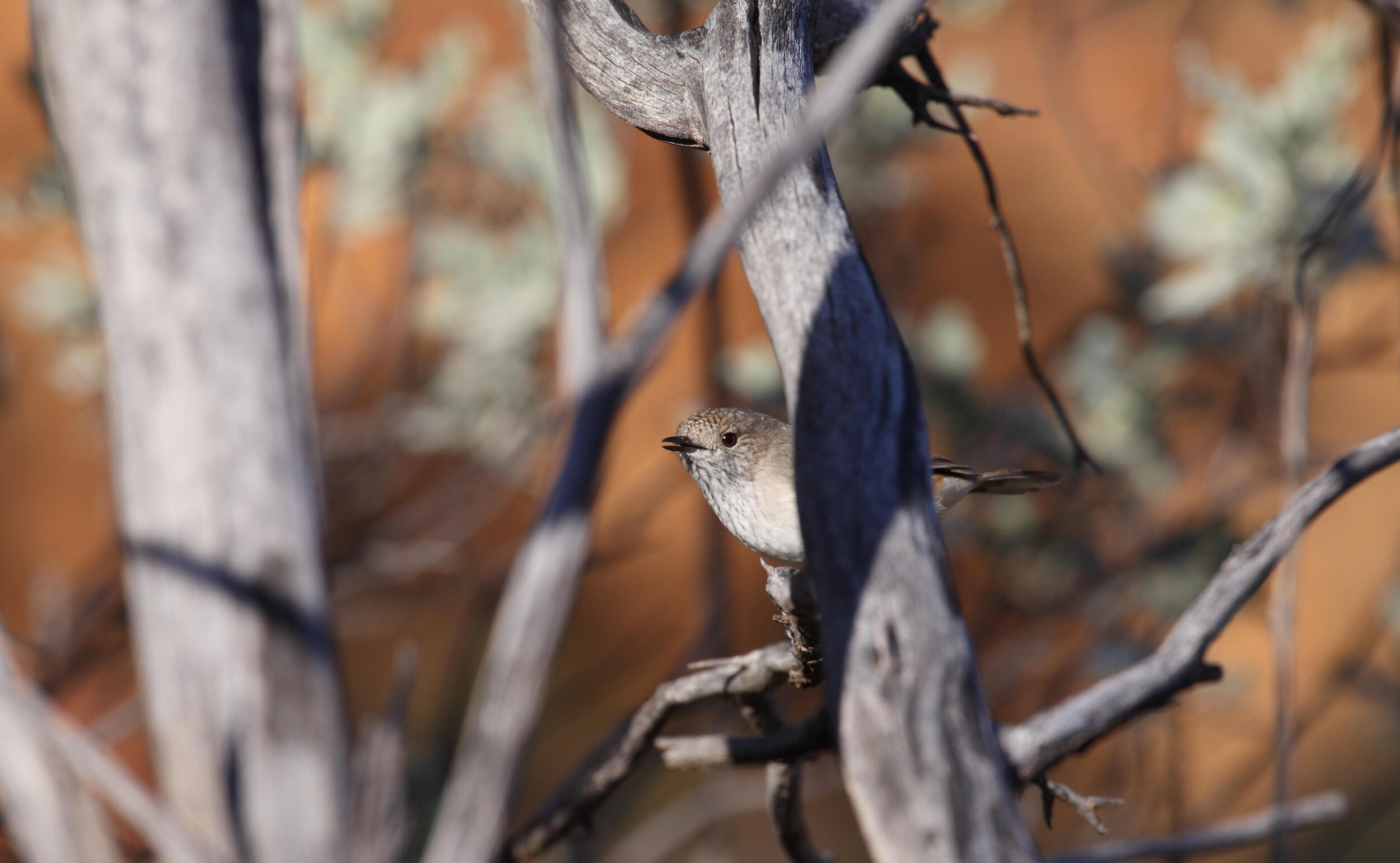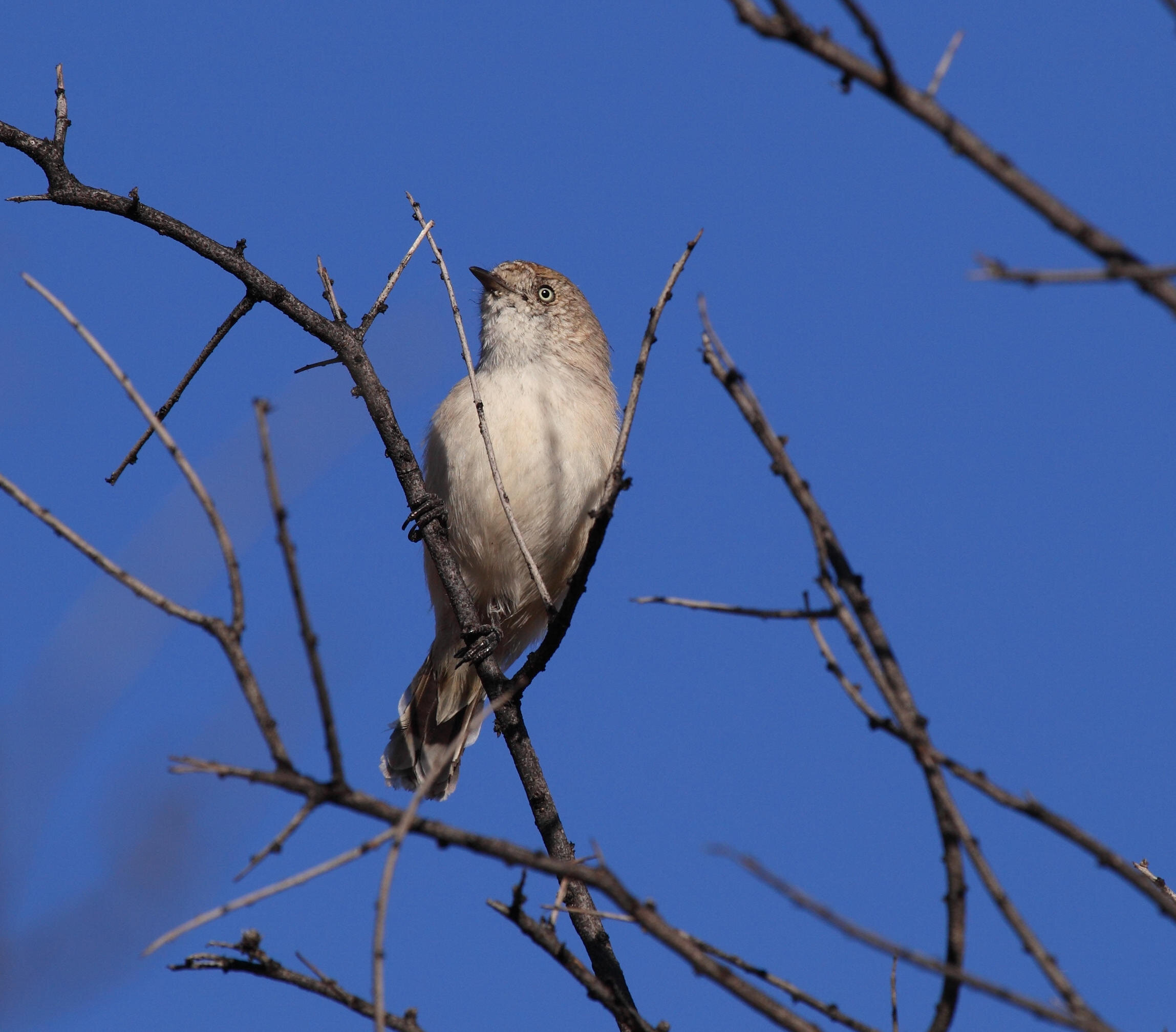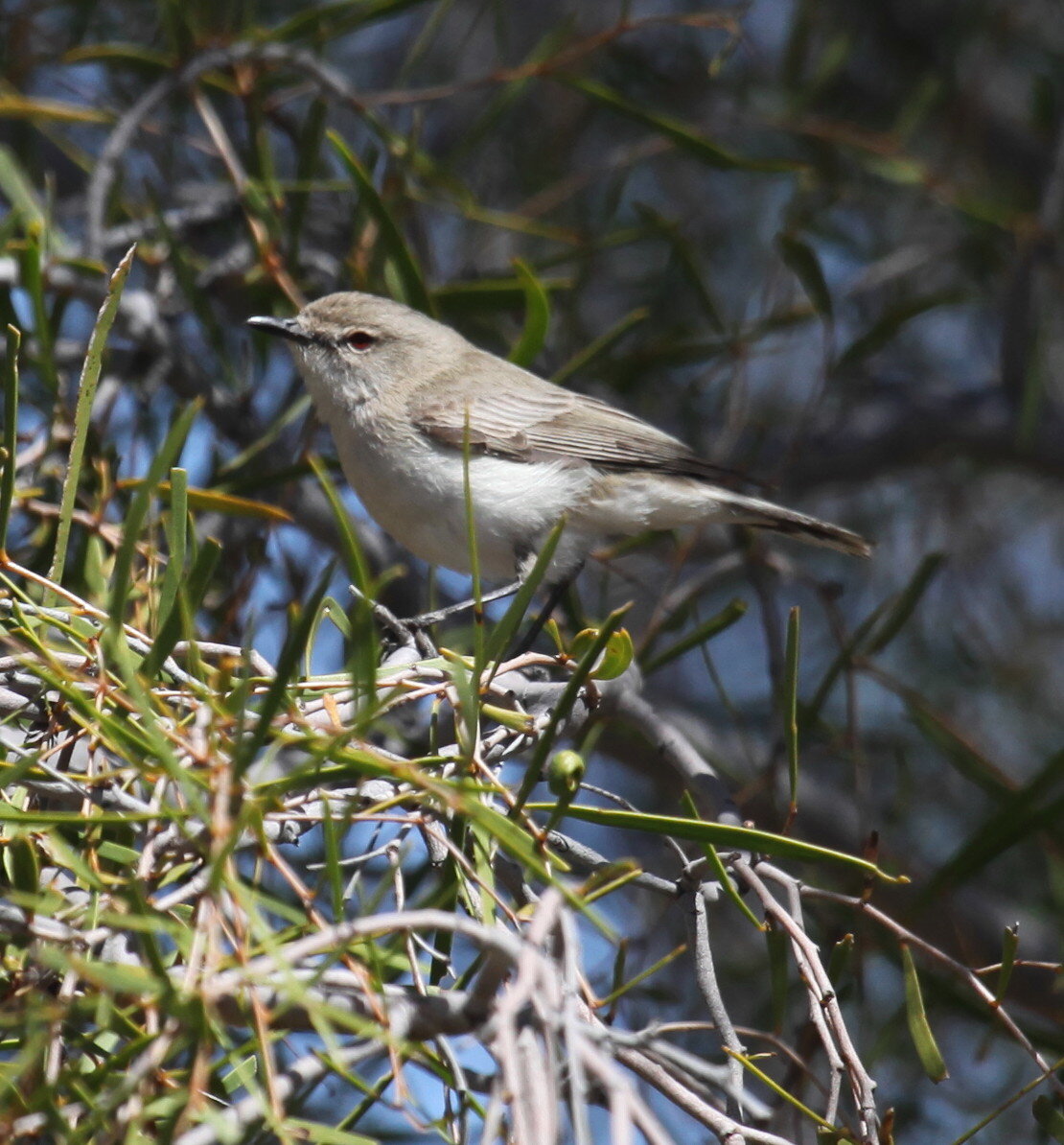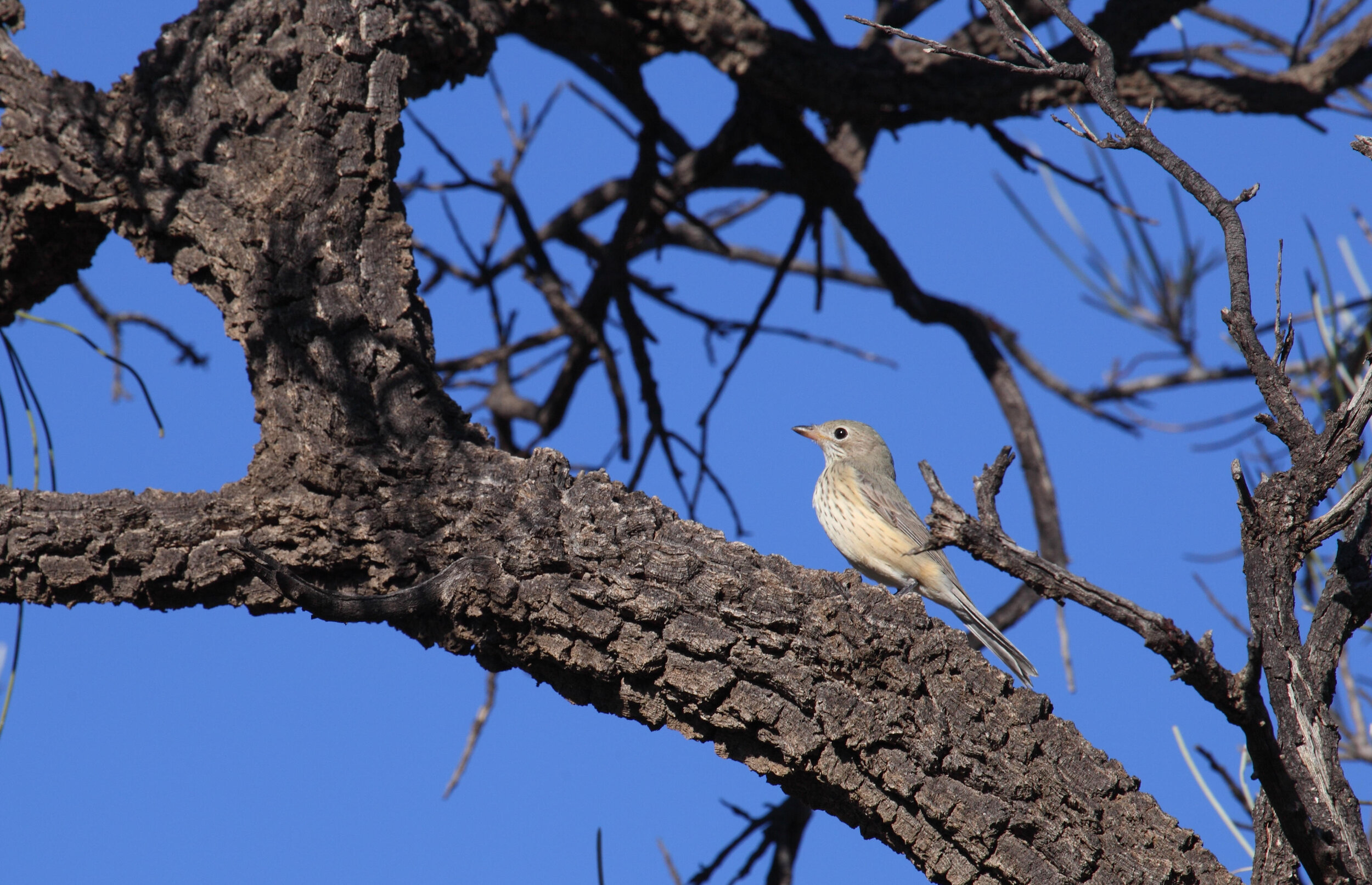Grey Expectations
Originally published in Australian Birdlife Vol. 10, No. 1, March 2021
Chris Watson investigates one of the most persistent conundrums in Outback ornithology—the comically indiscernible, but remarkably interesting Grey Honeyeater.
Grey Honeyeater Conopophila whitei, near Alice Springs. Mark Carter, used with permission.
“Poorly known, inconspicuous, small, grey…” says the Australian Bird Guide of the humble Grey Honeyeater. Australian Bird Names takes it a step further: “...’grey’ doesn’t quite do it justice, this really is a hard bird to characterise physically…”. In the early 20th Century Gregory Mathews tellingly referred to it as Inconspicuous Honeyeater. Almost a century later, Campbell, Woods, and Leseberg suggest that a “...subdued uniform dull grey plumage… and almost complete lack of field marks…” make it “...one of the most difficult Australian birds to locate.”
The Grey Honeyeater is in hallowed company as a species with few peers when it comes to being both challenging to find and difficult to identify. Definitive information about its habitat preferences and movements have, until very recently, been scant. It occurs at very low densities across a huge area of the most inaccessible parts of the continent.
A habit of sometimes foraging in mixed flocks with similar species only adds to its elusiveness. That list of confusing species is lengthy too and includes faintly marked females or immature birds of almost any species in the same size range that occupy the same habitat. Through thick mulga scrub, or at a distance or awkward angle, any of the following can and have been misidentified, at least in the first instance, (including by this author) as Grey Honeyeater: Inland, Chestnut-rumped, Yellow-rumped or Slaty-backed Thornbill; female/immature Rufous Whistler; Redthroat; Western Gerygone; female Hooded Robin; Jacky Winter; Black Honeyeater; Pied Honeyeater; Brown Honeyeater; and without a direct size comparison even Grey Shrikethrush and immature Black-faced Cuckooshrike have foxed birders seeking this drab little prize. (A gallery of possible confusion species below.)






Even those who are adept at identifying species from their vocalisations alone may not have a distinct advantage when it comes to Grey Honeyeaters. More than once I’ve been led a not-so-merry dance through the scrub by an Inland Thornbill or Redthroat with a penchant for Grey Honeyeater mimicry. In any case, Grey Honeyeaters are not always vocal and can have highly variable responses to playback so acoustic detection is not always possible.
Our understanding of the species’ preferred habitat and how it uses and moves within that habitat, could best be described as embryonic. Most published accounts make some reference to the species being at least partially nomadic but ecologist, zoologist and long-time resident of Alice Springs Mark Carter thinks this may not actually be the case.
“Past claims of nomadism are likely a misinterpretation of the variation in the birds’ detectability as it oscillates between breeding events and non-breeding. Perhaps, while the birds move quickly and regularly across large sites and ‘spread out’ during non-breeding seasons, they are actually sedentary overall on a larger regional scale.”
It’s a compelling argument built on Mark’s observations of wildly variable calling behaviour between breeding events and non-breeding seasons; calling is very frequent during the former and very rare in the latter. The species also has a frustrating habit of remaining mostly silent while feeding, which further explains why acoustic detection may be unlikely, even during breeding events.
Over the last two decades, Mark may have spent more time observing this species in the field and documenting its ecology than anyone else alive. He has put together a picture of the bird’s ecology which is at once revealing but possesses a too-familiar hint of foreboding of a species in decline due to habitat destruction, invasive species, and destructive fire.
As for Grey Honeyeater’s apparent sparsity in the landscape, everything we know suggests that it is what some ecologists might categorise as a K-selection species. This slightly outdated terminology simply provides a convenient way of categorising an organism’s reproductive strategy. K-selection species tend to live in complex but relatively stable environments, to reproduce slowly, have extensive parental care, be fiercely protective of offspring and go through a period of teaching their young. (The alternative is R-selection: think of mice, rabbits, and species that reproduce rapidly and in large numbers.) Grey Honeyeaters usually raise one chick per brood and Mark’s observations suggest that they are indeed aggressively protective and devote considerable time to teaching their fledged offspring the art of foraging for lerp scale and feeding on acacia canopy caterpillars and foliage-foraging ants.
Another characteristic of K-selected species is that they tend to be very vulnerable to environmental instability. All of Mark’s observations point to a retreating Grey Honeyeater population in Central Australia as invasive Buffel Grass steadily spreads through the landscape, simplifying ecosystems as it goes, smothering native flora and then ramping up fire intensity and frequency. The impact of fire on Grey Honeyeaters may be indirect but significant. Again, Mark has some interesting insights:
“Grey Honeyeaters are heavily reliant on lerp scale as a food source. The sap-feeding insects which produce this scale are fire-sensitive and intensively ‘farmed’ by various ant species so it’s likely that the distribution of Grey Honeyeater ultimately reflects the condition of the ant fauna and the severity of past fires.”
On top of the threat of Buffel Grass and increasing fire frequency, cattle overgrazing, climate change and other threatening processes surely play a role in rendering arid woodlands less complex and less appealing to this particularly fussy honeyeater.
Two important messages that arise from all of this are the immense value of contributions to citizen science projects like BirdLife Australia’s Birdata and Cornell’s eBird, especially for perennially data deficient species like the Grey Honeyeater, as well as the importance of having passionate and knowledgeable local advocates for birds, who can be out in the field year round to collect the observations that may be missed by visiting birders and short term research projects.
Under the careful eye of such dedicated observers a richer picture can emerge, even of the most superficially bland and apparently unremarkable of birds. The Grey Honeyeater is emblematic of this. It’s not just a boring little bush bird, charming birders only with the allure of its rarity or the challenge it presents to birding skills and fieldcraft. It’s a genuine marvel of Outback ecology. And with its many mysteries becoming less opaque through the work of regional birders like Mark, it can teach us plenty about the subtle and the not-so-subtle ways in which we’re impacting the environment.
Grey? Certainly. Dull? Never.
My thanks to Mark Carter who spoke to me during the preparation of this piece and kindly gave me access to his notes.
How to spot a Grey Honeyeater—and how to let us know
Alice Springs Desert Park has had a very good run with Grey Honeyeaters in recent years, with a bird regularly observed and even breeding in the park grounds. But if you’re keen to look farther afield, look for long-unburnt mulga woodlands with healthy understorey; forget playback; go slowly; go carefully; pick through mixed flocks meticulously.
And remember—if you do manage to spot a Grey Honeyeater let BirdLife Australia know via the Birdata app. Every sighting helps to complete the puzzle of this little Outback mystery and support BirdLife Australia in better protecting all our birds.

